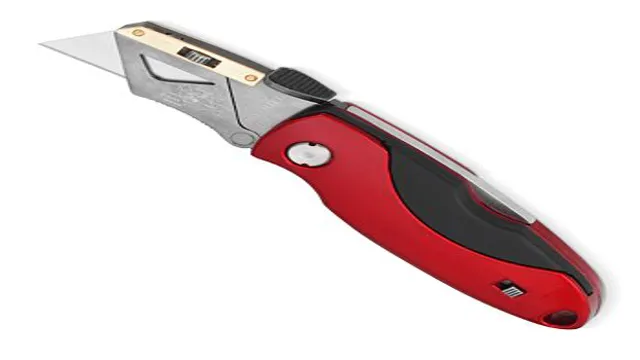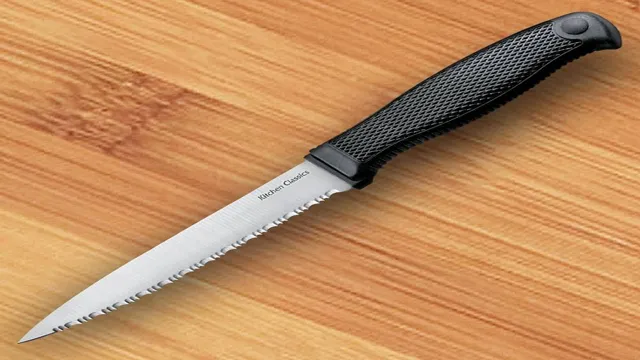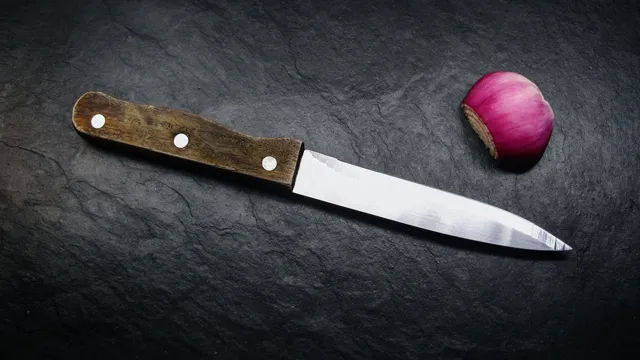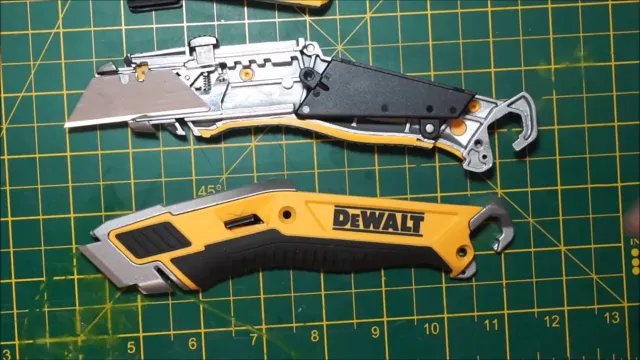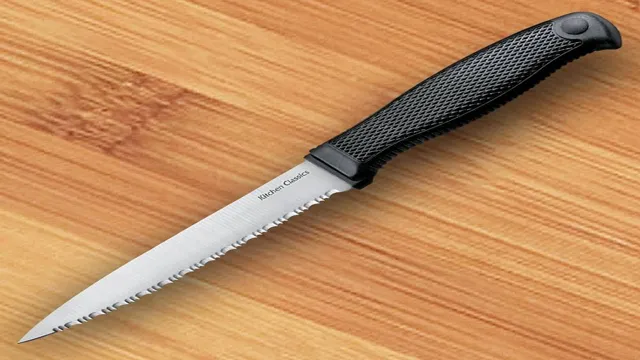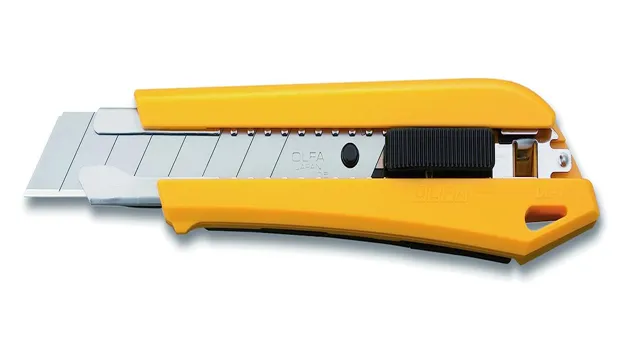How to Change Blade in Milwaukee Utility Knife: Easy Steps for a Smooth Process

Milwaukee utility knives are a staple in many toolboxes. With their sturdy construction and sharp blades, they are perfect for cutting through all sorts of materials. But what happens when the blade becomes dull and needs to be changed? Don’t worry, it’s a simple process that can be done in just a few steps.
In this article, we will discuss how to change the blade in your Milwaukee utility knife so you can get back to cutting with ease. So let’s get started!
Step 1: Safety First
Before attempting to change the blade in your Milwaukee utility knife, it is important to prioritize safety first. Make sure to securely lock the blade in place to prevent any accidental cuts or injuries. You can do this by activating the locking mechanism or by simply retracting the blade.
It is also important to choose a stable work surface and wear protective gloves to prevent any accidents. Check the blade and ensure that it is in good condition before removing it. If you encounter any difficulties while changing the blade, stop and seek assistance.
Remember, safety should always be your top priority when handling any cutting tools. Now that we have covered the importance of safety, let’s move on to the next step of changing the blade in your Milwaukee utility knife.
Wear gloves and make sure the blade is fully retracted and locked in place.
If you’re planning to use a retractable knife, make sure to put your safety first at all times. Start by wearing gloves that provide ample protection to your hands. These gloves can help you prevent accidental cuts or wounds while making precise cuts.
Handling a retractable knife without gloves can be dangerous, especially if you’re dealing with sharp edges. Once you have your gear on, ensure that the blade of the knife is fully retracted and locked in place. This simple yet crucial step can help you work more efficiently, and also prevent unwanted injuries.
A retractable knife can be a powerful tool, but if not used properly, it can also pose a significant risk to both yourself and others. So, always remember to put your safety first at all times.

Step 2: Remove the Old Blade
Now that you have gathered all the necessary equipment, it’s time to move to step two, which involves removing the old blade from your Milwaukee utility knife. First, locate the blade release button. This button can usually be found on the side of the knife handle.
Once you’ve located it, push it in and then carefully remove the old blade. Be mindful of the blade’s sharpness during this step, so you don’t accidentally hurt yourself. Some Milwaukee utility knives may come with a blade dispenser that allows you to safely and easily dispose of the old blade.
If this is the case, use it to store the old blade until you’re ready to dispose of it properly. If your knife doesn’t come with a dispenser, wrap the old blade in paper or another protective material, then dispose of it in a blade-safe container. Once you’ve removed the old blade, you’re ready to move on to the next step of installing the new blade.
Press and hold the blade release button to unlock the blade.
When it comes to changing the blade on your tool, it can be a bit confusing at first. However, with the right steps, it can be a breeze. The second step to removing the old blade is to press and hold the blade release button to unlock it.
This can usually be found near the blade housing on your tool. Once you hold down the release button, you should be able to easily slide the old blade out of the housing. It’s important to note that some tools may have a lock button that needs to be engaged before you can press the blade release button.
This may take a bit of practice to get the hang of, but don’t be discouraged. With a bit of patience, you’ll be able to remove the old blade like a pro in no time. Remember, safety always comes first when working with tools, so be sure to read the instructions carefully and follow all necessary precautions before proceeding.
Use a screwdriver or coin to turn the blade change dial counterclockwise and remove the old blade.
Removing an old blade from your appliance may seem like an intimidating task, but it’s actually quite simple with the right tools. To begin, find a screwdriver or coin that fits the blade change dial and insert it into the designated slot. Once inserted properly, turn the dial counterclockwise to release the old blade and remove it from the appliance.
This may require some force, but be patient and try not to damage the appliance or the blade itself. It’s crucial to remove the old blade safely before inserting a new one to avoid injury or further damage. By successfully completing this step, you’re one step closer to enjoying a well-functioning appliance with a brand new blade ready for use.
Step 3: Install the New Blade
Now that you’ve removed the old blade from your Milwaukee utility knife, it’s time to install the new one. First, make sure the blade is the correct size and type for your knife. Then, locate the blade release button and hold it down.
While holding the button, insert the new blade into the slot until you hear a click. Release the button and give the blade a tug to ensure it’s securely in place. Finally, retract the blade into the handle and test it out to make sure it cuts smoothly.
Changing the blade on your Milwaukee utility knife is a quick and easy process that will save you time and money in the long run.
Insert the new blade into the blade housing with the sharp edge facing out.
When it’s time to switch out the old blade on your tool, don’t panic! Installing a new blade may seem like a daunting task, but it’s actually quite simple. The key is to make sure you have the right blade for your tool and that the blade is facing the right way. In step 3 of replacing your blade, insert the new blade into the blade housing with the sharp edge facing outwards.
This is crucial because if the blade is installed in reverse, it won’t be able to cut efficiently or safely. Make sure to line up the blade with the alignment notches or grooves on the housing, and push it firmly into place until you hear a click. Once the blade is securely in place, you’re ready to start tackling your next project with your newly sharpened tool.
Remember to always follow the manufacturer’s instructions and wear protective gear when handling sharp tools. Happy cutting!
Turn the blade change dial clockwise until it clicks into place.
Installing a new blade on your saw can seem like a daunting task, but it doesn’t have to be. Step 3 involves turning the blade change dial clockwise until it clicks into place. This may seem simple, but it’s an essential step that ensures your new blade is secure and will operate safely.
It’s also important to check the blade’s direction before installation. Installing your blade in the wrong direction can lead to accidents and cause the blade to wear down faster. Remember, safety always comes first, so ensure your saw is off and unplugged when changing blades.
As you install the new blade, take your time, and be mindful of any adjustments needed for the specific saw you’re using. With a bit of patience and some careful attention to detail, you’ll have your saw up and running in no time.
Step 4: Test the New Blade
Now that you’ve successfully changed the blade in your Milwaukee utility knife, it’s time to put it to the test! To do this, open and close the knife repeatedly to ensure that the blade is secure and doesn’t wiggle or fall out. Next, get a piece of paper or cardboard and test out the sharpness of the new blade by making a few cuts. If the blade is dull or not cutting properly, it may not have been installed correctly or it could be a faulty blade.
In this case, you may need to replace the blade again or contact Milwaukee’s customer service for assistance. But if everything checks out, congratulations on a job well done! Your newly installed blade will help you tackle your next project with ease and precision.
Carefully retract the blade and ensure it is securely in place before use.
When replacing the blade on your tool, it’s important to carefully retract the blade and ensure it is securely in place before use. Step 4 is all about testing the new blade to make sure it’s functioning correctly. Start by turning on the tool and holding it steady, then gently lower the blade onto a piece of scrap material.
If the blade slides or wobbles, it may not be seated securely. Double-check the blade’s placement and try again. Once you’re confident the blade is in place, try cutting through the scrap material, slowly and carefully.
If the blade cuts smoothly and cleanly, you’re good to go. If, on the other hand, the blade binds or catches, or if the cut is jagged or uneven, you may need to make further adjustments to the blade’s placement. Remember, always prioritize safety when handling sharp tools and make sure your blade is securely in place before beginning any project.
Conclusion
So there you have it, folks – changing the blade in your Milwaukee utility knife is a breeze! With just a few simple steps, you can swap out your old blade for a fresh one and get back to slicing, dicing, and cutting like a pro. And who knows, with this newfound skill, you might just become the go-to guy or gal the next time a friend needs a blade changed. Now that’s what we call utility!”
By following these simple steps, you can easily change the blade in your Milwaukee utility knife and continue to use it safely and effectively.
Once you have successfully changed the blade in your Milwaukee utility knife, it’s important to make sure it’s working properly before using it. Testing the new blade is the fourth and final step of this process. Start by opening and closing the blade a few times to see if it operates smoothly.
You can also try cutting through a piece of cardboard or thin plastic to test the sharpness of the blade. If the blade operates smoothly and cuts effectively, you can safely use your newly replaced Milwaukee utility knife for your next cutting project. Remember to always practice caution when handling sharp tools like utility knives, and be sure to replace the blades regularly to ensure safe and efficient use.
FAQs
What is the process to change the blade in a Milwaukee Utility Knife?
First, ensure that the blade is fully retracted. Then, press and hold the blade release button located on the handle. Remove the old blade and insert the new blade. Release the blade release button to secure the new blade.
Do I need any special tools to change the blade in a Milwaukee Utility Knife?
No, you do not need any special tools to change the blade. The blade release button on the handle enables easy blade replacement.
How frequently should I change the blade in a Milwaukee Utility Knife?
It is recommended to change the blade after extensive use or when the blade becomes dull. A dull blade can cause the knife to slip and cause injury.
Can I use any brand of replacement blades in my Milwaukee Utility Knife?
It is recommended to use Milwaukee brand replacement blades for optimal performance and compatibility.
Is it safe to change the blade in a Milwaukee Utility Knife?
Yes, it is safe to change the blade when following proper instructions. Ensure that the blade is fully retracted and the release button is engaged before removing or inserting a new blade.
How can I dispose of old blades from my Milwaukee Utility Knife?
Wrap the old blade in thick paper or cardboard and dispose of it in a sharps container or a designated hazardous waste disposal unit.
Can I sharpen the blades in a Milwaukee Utility Knife instead of replacing them?
It is not recommended to sharpen the blades as it can cause damage to the blade and affect the performance of the knife. It is recommended to replace the blade when it becomes dull.

